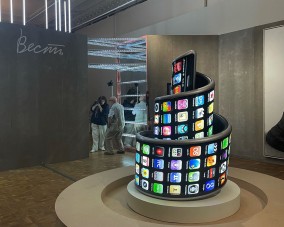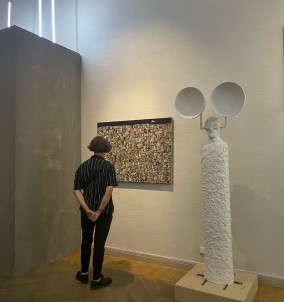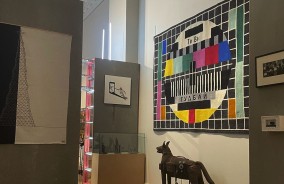Exhibition «Tidings»
The word ‘tidings’ appeared a long time ago, yet it is quite relevant to modern life filled with various kinds of news. The exhibition is devoted to the issues of transmitting and receiving information, its reliability and deceptiveness. The exhibition features 12 sections: Letter; Message as a Ritual; Newspaper; Radio; Telephone; Television; Letters, Codes, and Ciphers; Gossip, Rumours, and Misinformation; Messages from Space; Messengers; Signal; Digital World. The artists are more interested not in the technological aspects of communication processes but rather in humanistic ones. All the works are united by the motif of tidings – news – messages.
The exhibition begins with classic works of Russian art in which aspects that go beyond conventional interpretations are emphasized. Thus, in Ilya Repin’s painting Zaporozhians, the emphasis is placed on the expressiveness of speech communication enriched with gestures, facial expressions, pauses and intonation. It plays the role of a trigger to actualize the communicative “plots” of many works, including contemporary ones where online communication comes closer to the oral colloquial language.
Artworks of the second half of the 19th century related to the delivery and reading of private correspondence represent a personal “world around the letter” separated from public space. From here, threads stretch to Alexander Laktionov’s famous and popular painting Letter from the Front. Personal letters become a symbol of good tidings for all those who await them in troubled times.
The Russian Avant-Garde conceptualised communication in a global context. In 1921, Velimir Khlebnikov had a hope that radio would unite humanity. Vladimir Tatlin planned to place Radio of the Communist International in the upper moving cylinder of the tower Monument to the Third International. Aristarkh Chernyshev and Alexei Shulgin’s 3G International is both a homage to the great work and a critical comment on the pathos of globalisation.
The telephone embodied in paintings, graphic art and sculpture is particularly well represented at the exhibition. Throughout our history, telephone communication has had both dramatic overtones (“a call from above”, that is a call from the authorities) and a warm homely atmosphere. Depicted by different artists, the telephone always turns out to be more than just a thing – it tells its own stories. Today, this portable device holds a person’s entire life. New roles of the mobile phone, affection for it, the need to be online, the concentration of various “lines of fate” in one gadget and the fear of being disconnected – all these are the themes of the artists’ reflections.
A significant part of the exhibition is the section devoted to messages from Space. Ivan Govorkov and Elena Gubanova, Recycle group, Alla Urban, Grisha Bruskin and others reveal connections between images of cosmic matter and their signs on our planet as well as between earth and sky.
Since the mid-1990s, TV sets have become a symbol of nostalgic memories of childhood. This theme is revealed in the works by Konstantin Sutyagin, Sasha Braulov, Sergei Heato and Yulia Markos. The phenomenon of the rapid obsolescence of technical devices is also reflected in art: a laptop and a floppy disk are seen as almost archeological objects by street artist Yalta 1970 and Mayana Nasybullova.
The exhibition finishes with works of the new media art created by young artists. They are interested in the exchange of information between people and digital universe, as well as in metamorphoses of the human body in cyberspace and navigational processes.
The public is encouraged to turn on their imagination – together with the computer – and to feel the magic power of the word ‘message’. To feel something different and hidden apart from the modern technological stuffing in their monitors: the archangel’s announcement, a torch, an alarm bell, maritime signal flags, a handwritten copy of The Vedomosti newspaper from the times of Peter the Great, and a news ticker…
The exhibition is held in the Benois Wing until December 2, 2024.
We would like to express our gratitude to the GES-2 House of Culture for their support and participation in the exhibition project.
Russian Post is a partner of the postcard mailing activity at the exhibition.
Age restriction: 0+
Please note that part of the exhibition in Rooms 101–105 will be on show until 16 November 2024. Part of the exhibition in Rooms 106–109 will be open until 2 December 2024.
tags cloud
- #opening_of_a_branch
- #lecture
- #exhibition
- #virtual_exhibition
- #virtual_tour
- #online_exhibition
- #мультимедийная_выставка
- #poster_exhibition
- #online_event
- #masterclass
- #contest
- #занятие
- #festival
- #video_conference
- #round_table
- #conference
- #seminar
- #дошкольники
- #школьники
- #студенты
- #семья
- #серебряный_возраст
- #инклюзия
- #multimedia
- #Business_meeting_of_virtual_brances
- #The_Multimedia_Centre
- #Drammatika
- #деньмузеевВФРМ
- #ночьмузеевВФРМ
- #RussianMuseum130
- #RussianMuseum125
- #RussianMuseum120
- #RMcatalogues
- #Библионочь
- #книгиГРМ2019
- #игрыРМ
- #фильмыРМ
- #ночьискусствВФРМ
- #Artefact
- #100years_restorationRM
- #Peter_I_350
- #Antarctica200
- #folk_art
- #profession_restorer
- #RM_anniversary
- #SPb_anniversary
- #80летПобеды


